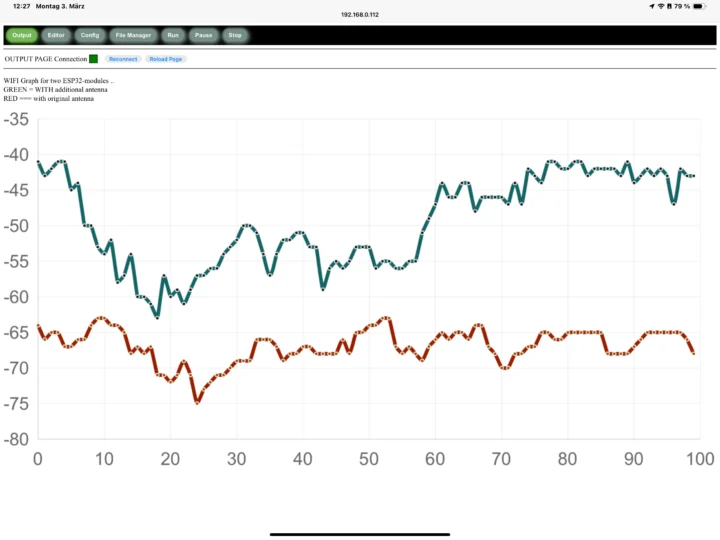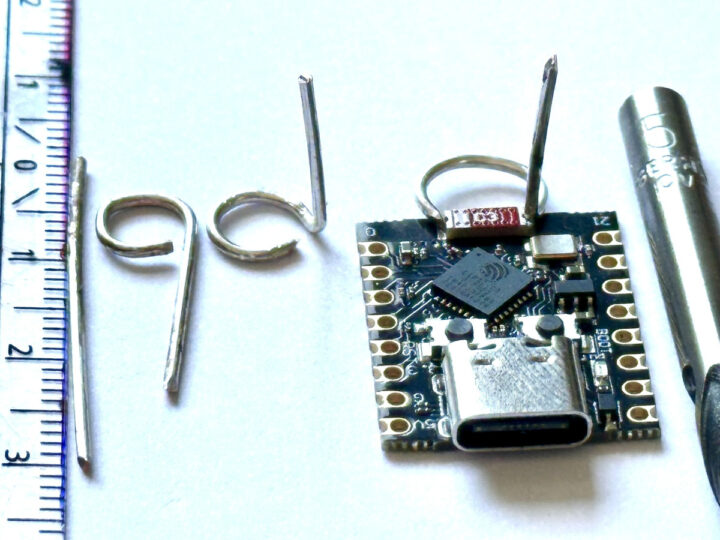There are plenty of small ESP32-C3 IoT boards with a USB-C connector on the market, and while they all look very similar, antenna designs differ, and less thought-out ones may severely impact the WiFi and Bluetooth range.
Peter Neufeld decided to hack one of those cheap ESP32-C3 boards by adding a custom antenna, and this resulted in the board having more than twice the range and almost three times in some cases.
Those tiny boards are cramped, so there’s very little space around the ceramic antenna typically used, leading to poor RF performance. To work around that issue, Peter added a 31mm long antenna made of silver-plated wire, making a loop of about 8mm in diameter outside of the board and soldered on the ceramic antenna’s solder joints, and the rest of the wire (about 15mm) points upwards. As you can see from the photo above, he didn’t remove the ceramic antenna.
So what are the results? Not bad… 6 to 10+ dB improvements based on measurements using Peter’s custom RSSI logger written for ANNEX32 BASIC, a version of the BASIC programming language designed to run on ESP32 microcontrollers. You’ll find the code at the end of the blog post detailing the antenna hack. We can see the signal strength (RSSI) comparison of two ESP32 modules: one unmodified and one with the new antenna in the chart below.

He further explains that theoretically, every 6 dB increase in signal strength corresponds to a doubling of the range, and practical testing revealed the modified ESP32-C3 SuperMini module was able to establish a reliable WiFi connection in areas where the unmodified module could not, or was unstable.
Circuit Helper tried Peter’s antenna hack on his own ESP32-C3 boards and managed to triple the range. He reported his experiments in the video embedded below.
As a side note, Peter also provides feedback on the video above, which Circuit Helper added to the video description:
Firstly the antenna he described is shorter than the one shown in the video, the total length is 31 mm including the loop. In the video the antenna is ~30 mm with the loop adding an additional ~15 mm. I’ve compared the RSSI of both designs and found that the shorter antenna is slightly less efficient (which is an interesting finding in itself), but the gains made using the longer wire might have undesirable side effects in terms of radiation pattern etc. Another great point from Peter was in regards to the matching between the ESP C3 and chip antenna, it’s bad… there is so much reflected power that it causes overheating in the ESP, so reducing the Tx power in software can actually increase the performance, which is counterintuitive but tally’s with what some people have noted in the comments! Very interesting information and thanks again to Peter for the original design and great insight!
Via Hackaday.

Jean-Luc started CNX Software in 2010 as a part-time endeavor, before quitting his job as a software engineering manager, and starting to write daily news, and reviews full time later in 2011.
Support CNX Software! Donate via cryptocurrencies, become a Patron on Patreon, or purchase goods on Amazon or Aliexpress





